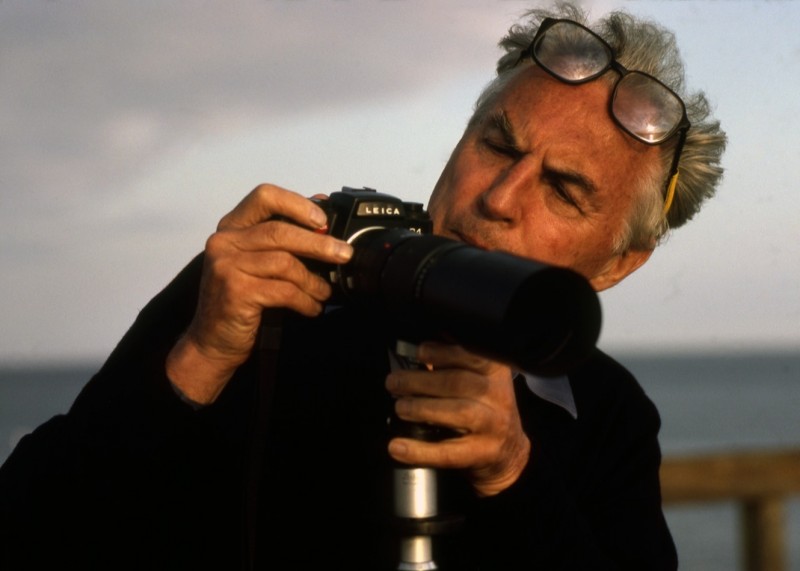Ernst Haas: 100 years
Ernst Haas: 100 years
March 2, 2021

“The vision of a painter, the feelings of a composer and the soul of a mystic.” According to a 1985 issue of Leica Fotografie, these elements are key to the photographer‘s impressive work. Ernst Haas himself underlined this assessment: “I would probably have become a painter, if it were not for the War. But I would have been equally happy as a composer. In Vienna, where I grew up, there was music everywhere. This is the reason, I am sure, why so many of my photographs contain a musical element. Indeed, there is sometimes more music than objective photography.”
At the time these words appeared in the magazine, Haas was 64 years old, and extremely successful as a photojournalist, commercial photographer and creative photo essayist, as well as with his photo books and exhibitions. His artistic colour photographs, in particular, had long been considered legendary and were very popular. He was a renowned member of the Magnum Agency: in fact, he had joined back in 1949, as the youngest member accepted into the group at the time. His reportage on soldiers returning from captivity, photographed at Vienna's Südbahnhof when the photographer was only 26, had a decisive impact upon his career. The emotional and touching series about the men and the families who waited for them was first published in Heute; and, shortly afterwards, in Life. In 1951, Haas moved to New York. His reportage work was increasingly replaced by picture essays.
In 1949, he became the owner of a Leica, and began to discover colour photography, using Kodachrome material. His Magic Images of New York, a twenty-four-page colour photo essay, appeared in Life in 1951. It was both his and the magazine's first comprehensive, colour feature. He developed an innovative approach, founded primarily on long shutter speeds, giving the pictures the illusion of movement. He roamed around New York with his Leica for months, photographing street lights, wall details, and making abstract compositions with features overlooked by most. In 1962, he was given a solo exhibition at the Museum of Modern Art in New York.
Even though he continued to take on reportage assignments in black and white, colour remained his defining theme. His most successful photo book was to be The Creation. The book resulted from his collaboration with director John Houston on the monumental US-Italian film The Bible, in 1966: it was Haas who put together the opening creation sequence. In the following years, he further experimented by adding audiovisual elements to his pictures; he considered that these images should be understood as musical, because “they communicate directly and need no interpretation”. His professional eye, and precise understanding of photography’s suggestive power, served him well during international advertising campaigns. Even though these were directed at the masses, Haas still saw himself as an artist and a picture-taking poet.
On September 12, 1986, Ernst Haas passed away unexpectedly in New York, following a stroke. March 2, 2021 marks the 100th anniversary of his birth. (Ulrich Rüter)
Image: © Todd Weinstein
At the time these words appeared in the magazine, Haas was 64 years old, and extremely successful as a photojournalist, commercial photographer and creative photo essayist, as well as with his photo books and exhibitions. His artistic colour photographs, in particular, had long been considered legendary and were very popular. He was a renowned member of the Magnum Agency: in fact, he had joined back in 1949, as the youngest member accepted into the group at the time. His reportage on soldiers returning from captivity, photographed at Vienna's Südbahnhof when the photographer was only 26, had a decisive impact upon his career. The emotional and touching series about the men and the families who waited for them was first published in Heute; and, shortly afterwards, in Life. In 1951, Haas moved to New York. His reportage work was increasingly replaced by picture essays.
In 1949, he became the owner of a Leica, and began to discover colour photography, using Kodachrome material. His Magic Images of New York, a twenty-four-page colour photo essay, appeared in Life in 1951. It was both his and the magazine's first comprehensive, colour feature. He developed an innovative approach, founded primarily on long shutter speeds, giving the pictures the illusion of movement. He roamed around New York with his Leica for months, photographing street lights, wall details, and making abstract compositions with features overlooked by most. In 1962, he was given a solo exhibition at the Museum of Modern Art in New York.
Even though he continued to take on reportage assignments in black and white, colour remained his defining theme. His most successful photo book was to be The Creation. The book resulted from his collaboration with director John Houston on the monumental US-Italian film The Bible, in 1966: it was Haas who put together the opening creation sequence. In the following years, he further experimented by adding audiovisual elements to his pictures; he considered that these images should be understood as musical, because “they communicate directly and need no interpretation”. His professional eye, and precise understanding of photography’s suggestive power, served him well during international advertising campaigns. Even though these were directed at the masses, Haas still saw himself as an artist and a picture-taking poet.
On September 12, 1986, Ernst Haas passed away unexpectedly in New York, following a stroke. March 2, 2021 marks the 100th anniversary of his birth. (Ulrich Rüter)
Image: © Todd Weinstein
